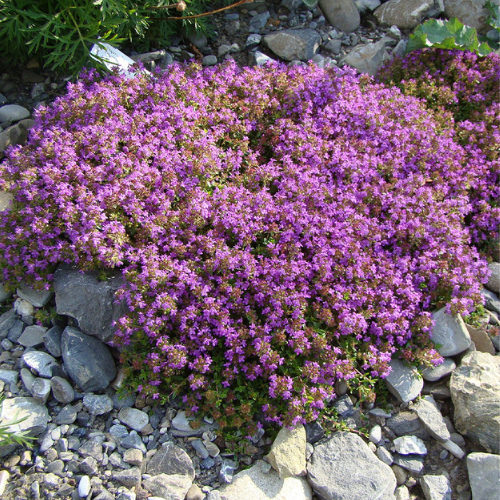
How To Grow Creeping Thyme From Seeds
Share
Thyme is a perennial herb with small, woody stems and delicate, fragrant leaves.
It is a popular choice for use in cooking and as a decorative plant in gardens.
Creeping thyme (Thymus praecox) is a variety of thyme that is known for its ability to spread horizontally, making it a good choice for use as a groundcover.
It has small, round leaves and produces tiny purple or pink flowers in the summer.
Creeping thyme is easy to grow and is resistant to pests and diseases.
It is a hardy plant that can tolerate drought and cold temperatures, making it suitable for growing in a variety of climates.
In the garden, creeping thyme can be used as a border plant, in rock gardens, or as a groundcover.
It is also a popular choice for use in herb gardens, as it is a versatile herb that can be used in a variety of dishes.
Creeping Thyme Ground Cover can be grown from seed, and it takes 14 to 21 days to sprout in USDA Zones 3 - 9.
Thyme ground cover grows in well drained soil that is either neutral or slightly alkaline and loves full sun.
Creeping Thyme self-sows easily, dropping it seeds after blooming season is over. This maintains a vigorous mat of Creeping Thyme.
Thyme is a great choice for nearly any lawn project.
1.) PLANTING INDOORS
Ideal, is to sow the Creeping Thyme Seed indoors 6 - 8 weeks before the last frost.
Here are a few steps guide to follow for growing creeping thyme from seeds:
✅ Gently scatter thyme seeds on top of the soil in the container you will be planting into.
✅ Next, gently scatter a little soil over the seeds or no covering.
✅ Water thoroughly.
✅ Cover with a plastic wrap.
✅ Place the container in a warm location at 70 Fahrenheit.
✅ Provide a good light source.
✅ Creeping Thyme seeds will germinate from 1 to 4 weeks, depending on temperature.
✅ Once Creeping Thyme seedlings are 2-3 inches high, plant them where you will be growing thyme in your garden.
Before transplanting prepare the soil. First, you’ll need to kill off all the grass where you intend to plant. Dig soil up deep and make sure you remove any trace of roots. Turn the soil completely, pulling out any roots that remain. Soil for Thyme should drain well for best results. Organic compost may help. When tilling in the compost, do it to a depth of only six inches or so; not the standard 12 inches (thyme is a shallow rooter). When planting Thyme seedling water the soil thoroughly, to a depth of at least four inches.
Plant creeping thyme 6 to 12 inches apart to allow for its spreading habitat.
Thyme may be drought tolerant, but it needs water to get established.
2.) PLANTING OUTDOORS
✅ Plant creeping thyme seeds directly outside after the danger of frost has passed.
✅ Prepare a seed bed, loosen the soil and remove weeds. Digging soil up deep and make sure you remove any trace of roots. Turn the soil completely, pulling out any roots that remain.
✅ Scatter the Creeping Thyme ground cover seeds evenly and press them lightly into the soil.
✅ Keep the soil consistently moist, but not soaked.
Thyme prefers a sandy, dry soil. Avoid planting in heavy, wet soils.
Usually, a thyme plant is grown from a division. Thyme is easy to divide.
In the spring or fall, find a mature thyme plant.
Use a spade to gently lift the clump of thyme up from the ground.
Tear or cut a smaller clump of thyme from the main plant, making sure there is a root ball intact on the division.
Replant the mother plant and plant the division where you would like to grow the thyme herb.
Important keep weed-free as they compete for nutrients with the young thyme plants. Once established the plants would benefit from mulch to help discourage weeds.
Creeping thyme takes one year to get established, and then begins to spread in its second season.
Every spring cut thyme cover plants back to half its previous height to retain the tender stems and bushy habit.
After 3-4 years plants will become woody and you will want to plant them over again from seed.
Creeping Thyme is a beautiful ground cover for landscaping (sometimes as a lawn substitute), between stepping stones or rock crevices, and to edge garden beds.
